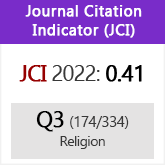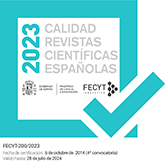The joining and separating of words in the Dotrino para criaturas: the outcome of the editorial crossover between sephardim and ashkenazim, or a willingness innovation?
DOI:
https://doi.org/10.3989/sefarad.022-010Keywords:
Yisrael Bajar Hayim, Graphic layout, Aljamiado Judeo-Spanish, Errata, 19th Century, Jewish Community of ViennaAbstract
This paper analyzes the alleged typographic errors of a brief pedagogical text in Aljamiado Judeo-Spanish: Dotrino para criaturas. This text by Yisrael Bajar Hayim of Belgrade was published as an appendix to the prayer book Bet Tefilá Icaré, in one of the printing houses of the Jewish Community of Vienna. The goal of this work is to determine whether the errors related to the graphic arrangement of the text are due to a misinterpretation of the manuscript by a probably Ashkenazi editor, or can be explained as a voluntary innovation of its author. Thus, it has been carried out a thorough analysis of the unusual graphic joints and separations of the Vienna 1821/1826 and Trieste 1829 editions, trying to establish patterns that indicate some kind of systematicity or a mere arbitrariness in the text.
Downloads
References
Bunis, David M. (1974): The Historical Development of Judezmo Orthography: A Brief Sketch (=Working Papers in Yiddish and East European Jewish studies 2 [New York: YIVO Institute]).
Bunis, David M. (1996): «Yisrael Haim of Belgrade and the History of Judezmo Linguistics», Histoire, Epistémologie, Langage 18:1, pp. 151-166. https://doi.org/10.3406/hel.1996.2453
Cohen, Dov (2021): Thesaurus of the Ladino Book 1490-1960. An Annotated Bibliography (Jerusalem: The Ben-Zvi Institute [en hebreo]).
García Moreno, Aitor (2002): «La puntuación en textos sefardíes aljamiados», Res Diachronicae 1, pp. 169-177.
García Moreno, Aitor (2004): Relatos del pueblo ladinán: Me'am lo'eź de Éxodo (Madrid: CSIC).
García Moreno, Aitor (2012): «De la pervivencia (o no) de algunas innovaciones morfosintácticas del judeoespañol castizo», Cuadernos Dieciochistas 13, pp. 229-247.
García Moreno, Aitor (2019): «Contienda de normas en el judeoespañol escrito del siglo XIX», en Eugenio Bustos Gisbert y Juan Pedro Sánchez Méndez (eds.) La configuración histórica de las normas del castellano, (Valencia: Tirant Humanidades, pp. 397-413.
García Moreno, Aitor y Fco. Javier Pueyo Mena (2013-): Corpus Histórico Judeoespañol - CORHIJE (CSIC, recurso en línea).
Hassán, Iacob M. (2008): «Sistemas gráficos del español sefardí», en Iacob M. Hassán, Ricardo Izquierdo Benito y Elena Romero Castelló (coords.) Sefardíes, literatura y lengua de una nación dispersa: XV Curso de Cultura Hispanojudía y Sefardí de la Universidad de Castilla La Mancha (Cuenca: Universidad de Castilla-La Mancha) pp. 119-144.
Laguna Campos, José (2005): «Gramática de las preposiciones», en M.ª Auxiliadora Castillo Carballo, Olga Cruz Moya, Juan Manuel García Platero y Juan Pablo Mora Gutiérrez (coords.) Las gramáticas y los diccionarios en la enseñanza del español como segunda lengua. Deseo y realidad: Actas del XV Congreso Internacional de ASELE, (Sevilla: Universidad de Sevilla) pp. 526-533.
Quintana, Aldina (2012): «Judeo-Spanish: From Linguistic Segregation outside the Common Framework of Hispanic Languages to a de facto standard», en Malka Muchnik y Tsvi Sadan (Tsuguya Sasaki) (eds.) Studies in Modern Hebrew and Jewish Languages Presented to Ora (Rodrigue) Schwarzwald (Jerusalem: Carmel) pp. 697-714.
Quintana, Aldina (2012): Corpus Diacrónico Anotado del Judeoespañol - CoDiaJe (recurso en línea).
Quintana, Aldina (2013): «Israel bar Ḥayim de Belogrado, the "Write as you speak" principle and the nomenclature in the Sefer Otsar HaḤayim (1823)», PaRDeS: Zeitschrift der Vereinigung für Jüdische Studien 19, pp. 35-55.
Romero, Elena (1992): La creación literaria en lengua sefardí (Madrid: Editorial Mapfre).
Weingreen, Jacob (1959): A Practical Grammar for Classical Hebrew (Oxford: OUP Oxford).
Downloads
Published
How to Cite
Issue
Section
License
Copyright (c) 2022 Consejo Superior de Investigaciones Científicas (CSIC)

This work is licensed under a Creative Commons Attribution 4.0 International License.
© CSIC. Manuscripts published in both the printed and online versions of this Journal are the property of Consejo Superior de Investigaciones Científicas, and quoting this source is a requirement for any partial or full reproduction.All contents of this electronic edition, except where otherwise noted, are distributed under a “Creative Commons Attribution 4.0 International” (CC BY 4.0) License. You may read here the basic information and the legal text of the license. The indication of the CC BY 4.0 License must be expressly stated in this way when necessary.
Self-archiving in repositories, personal webpages or similar, of any version other than the published by the Editor, is not allowed.
Funding data
Ministerio de Ciencia e Innovación
Grant numbers PID2021-123221NB-I00














